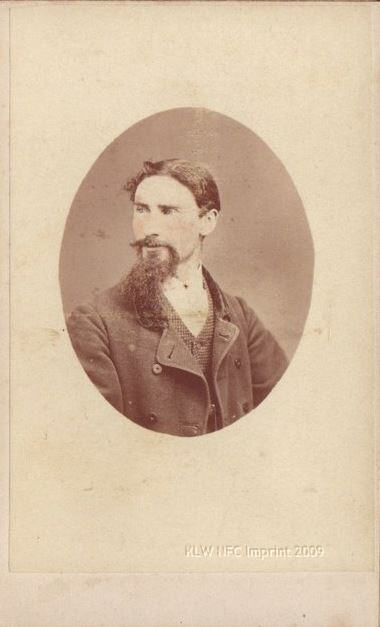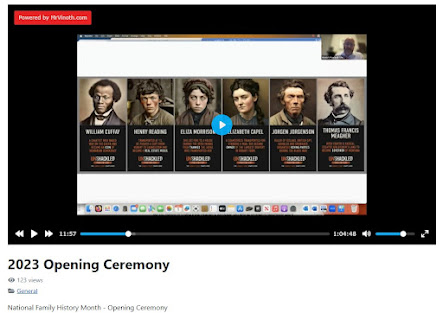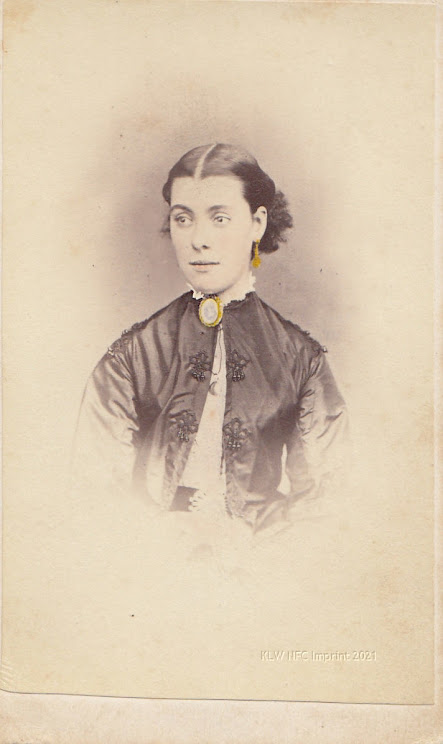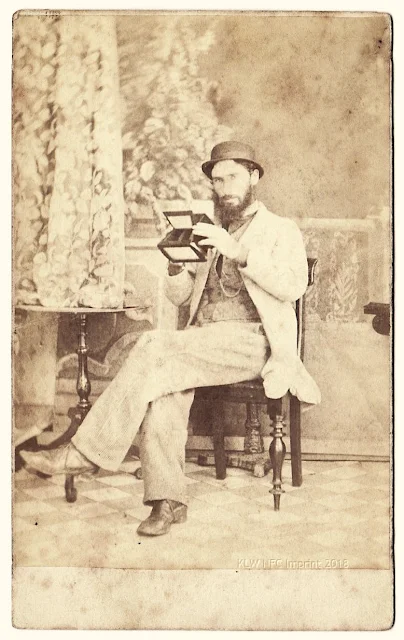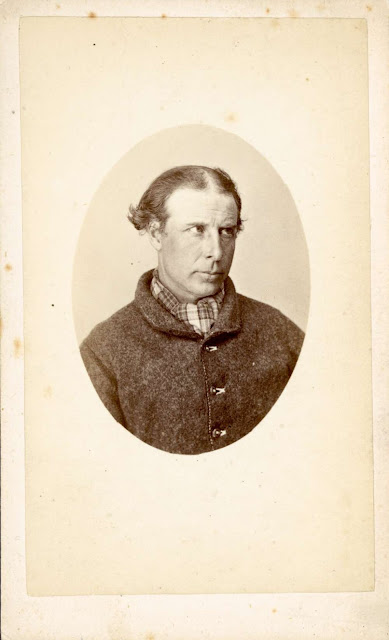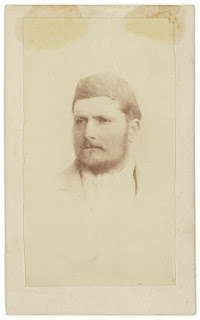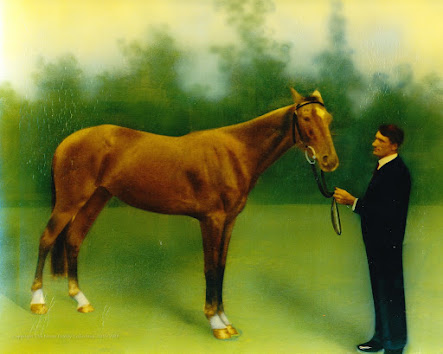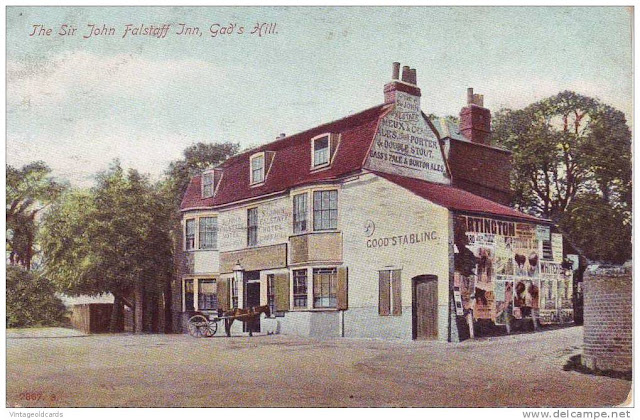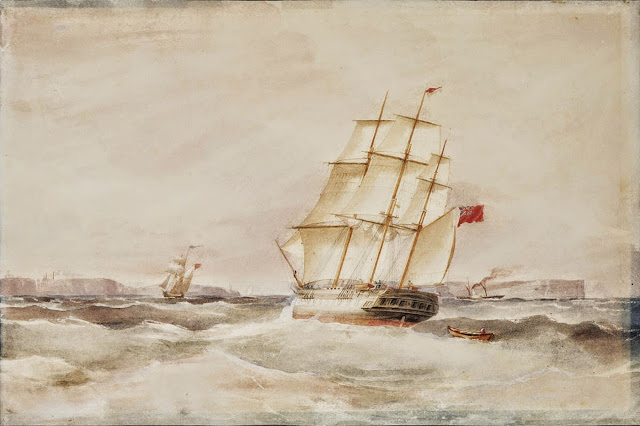
Mary Ann Nevin (1844-1878), sister of Thomas J. Nevin,
dipping a glass at New Town rivulet, Kangaroo Valley Hobart Tasmania, ca. 1870.
Salt paper stereograph taken by Thomas J. Nevin ca. 1870
Photo © KLW NFC Imprint Private Collection 2012
When the Nevin family of Kangaroo Valley, Hobart, sat down to read the Mercury on the 4th October 1865, they must have despaired at the notice it contained about their application for aid of £25 p.a. to open a school at Kangaroo Valley, especially Mary Ann Nevin, 21 years old, and determined to start her working life as a teacher. The reporter had mispelt the family name - McNevis instead of Nevin. A week later, when The Mercury reported that Mary Ann's application was rejected, the reporter again mispelt her name as NEVEN.
Source: BOARD OF EDUCATION. (1865, October 4). The Mercury (Hobart, Tas. : 1860 - 1954), p. 2. Retrieved February 2, 2014, from https://nla.gov.au/nla.news-article8835291
TRANSCRIPT
KANGAROO VALLEY
An application was received for the establishment of a school at Kangaroo'Valley.
Dr. BUTLER said that the school was proposed by a family named McNevis [sic], and Miss McNevis [sic] was willing to teach. They proposed undertaking the school on receiving aid to the amount of £25 a year.
Mr. MACDOWELL said he thought children from Kangaroo Valley could very well attend the New Town school.
Dr. OFFICER said the road was very bad. He thought the application reasonable.
After discussion, the matter was put aside for the report of the Inspector.

Source: The Mercury, 11 October 1865
BOARD OF EDUCATION. (1865, October 11). The Mercury (Hobart, Tas. : 1860 - 1954), p. 2. Retrieved April 16, 2014, from https://nla.gov.au/nla.news-article8835416
BOARD OF EDUCATION.Family friend and amateur photographer Morton Allport was included among her supporters in her application, but to no avail. The application was rejected on the grounds that the children named as prospective students resided closer to the Public School at New Town, and that the road to Kangaroo Valley was bad. The Nevins were not asking for a building to be constructed; in all likelihood, the proposed school would utilise the Wesleyan Chapel and its Sunday School room constructed at Kangaroo Valley in 1859. Despite the setback, Mary Ann and her father John Nevin proceeded with the school on their own account. On the 28 May 1875, The Mercury reported that the Department of Education had approved John Nevin's application to operate a night school for adult males.
TUESDAY, l0th OCTOBER, 1865.
The Board met at 2.30 p.m. yesterday afternoon.
Present.- Mr. Macdowell in the chair, Dr.Officer, Mr. Tarleton, Mr. T. Westbrook, and Mr. Watkins. -
Mr. Stephens, Inspector of Schools, and Mr. Burgess, Secretary to the Board.were also present.
The minutes of the last meeting were read and confirmed.
KANGAROO VALLEY.
Considered, the Inspector's report on an application for aid to a school at Kangaroo Valley, New Town, conducted by Miss Neven,[sic] together with a memorial from Mr. Morton Allport and others in support of application.
It appeared from Mr. Stephens' report, that all the children named in the application resided within an easy distance of the Public School at New Town ; it was decided that aid could not be given.
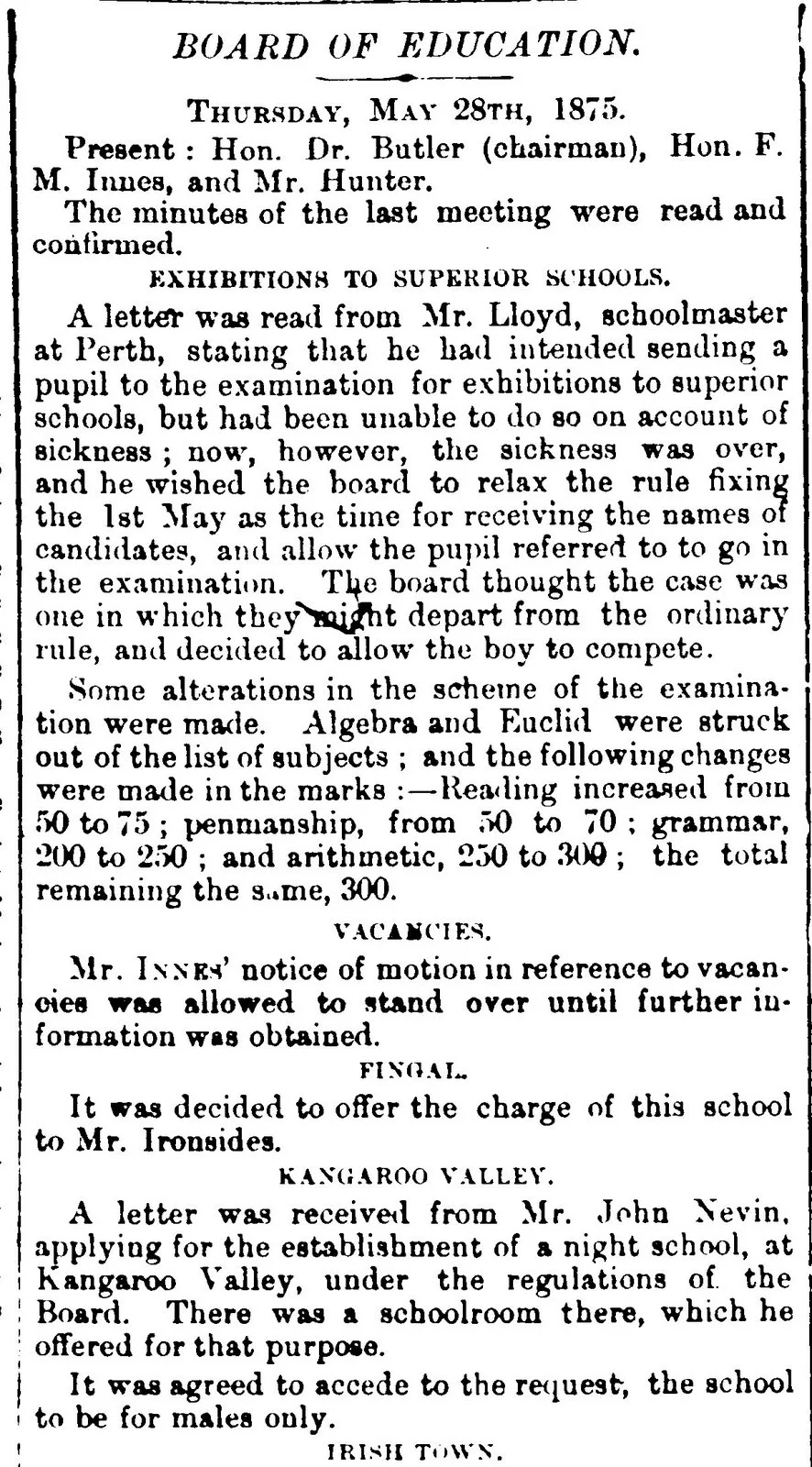
The Mercury, 28 May 1875. John Nevin's night school for males.
TRANSCRIPT
KANGAROO VALLEYThe spelling errors regarding her family name made by the newspaper in 1865 must have irritated Mary Ann Nevin, as she was not only a teacher, she won a Spelling Bee held at the Oddfellows Hall which was reported in The Mercury on 25 September 1875. Some of words the contestants were required to spell were difficult indeed and some are archaic today.
A letter was received from Mr. John Nevin, applying for th establishment of a night school, at Kangaroo Valley, under the regulations of the Board. There was a schoolroom there, which he offered for that purpose.
It was agreed to accede to the request, the school to be for males only.

Thomas Nevin's portraits printed as cartes-de-visite in different oval mounts portraits
of himself and his sister Mary Ann Nevin, 1873.
From © KLW NFC & The Nevin Family Collections Arr
The Tasmanian Museum and Art Gallery holds several stereographs taken by Thomas Nevin of the New Town Public School. This one of Mary Nevin, accompanied by a man and five children, with the roof a building visible, was identified by the TMAG as the school house at Kangaroo Valley:


Stereograph by Thomas J. Nevin, ca. 1870
Verso blank. Inscription "School House Kangaroo Valley"
Photos recto and verso copyright © KLW NFC Imprint 2014-2015
Taken at the Tasmanian Museum and Art Gallery, 10 November 2014
TMAG Ref: Q16826.1.2


Stereograph by Thomas J. Nevin, ca. 1870 of the New Town Public School
Verso stamp "Thos Nevin New Town"
Inscriptions "New Town Public School 1870s per G. Stilwell"
Photos recto and verso copyright © KLW NFC Imprint 2014-2015
Taken at the Tasmanian Museum and Art Gallery, 10 November 2014
TMAG Ref: Q16826.27

Thos Nevin New Town studio stamp
TMAG Catalogue online 2005
- Q16826.28 ITEM NAME: photograph: MEDIUM: albumen silver print sepia toned stereoscope, MAKER: T J Nevin [Photographer]; DATE: 1870s DESCRIPTION : New Town Public School
- Q16826.27 ITEM NAME: photograph: MEDIUM: albumen silver print sepia toned stereoscope, MAKER: T J Nevin [Photographer]; DATE: 1870s DESCRIPTION : New Town Public School
- Q16826.1.2 ITEM NAME: photograph: MEDIUM: albumen silver print sepia toned stereoscope, MAKER: T Nevin ? [Artist]; TITLE: 'School House Kangaroo Valley' DATE: 1860s DESCRIPTION : This photo depicts three adults and four children at Kangaroo Valley (Lenah Valley) INSCRIPTIONS & MARKS: A Pedder
- Q16826.1.1 ITEM NAME: photograph: MEDIUM: salted paper print stereoscope, MAKER: T Nevin ? [Artist]; TITLE: 'School House Kangaroo Valley' DATE: 1860s DESCRIPTION : This photo depicts three adults and four children at Kangaroo Valley (Lenah Valley) INSCRIPTIONS & MARKS: A Pedder
Morton Allport and the Memorial

Title: [Self portrait of Morton Allport]
Creator: Allport, Morton, 1830-1878, photographer
Publisher: [1854]
Description: 1 photograph : silver albumen print; 10 x 7 cm
Format: Photograph
ADRI: AUTAS001139593974
Source: Allport Library and Museum of Fine Arts
The rejection of Mary Ann Nevin's application for school aid, published by the Mercury on 11th October 1865, mentioned support from photographer and naturalist Morton Allport with an offer of a memorial, without specifying details or purpose. A memorial to what or whom? There are at least four possibilities:
1. A very personal memorial for Rebecca Jane Nevin (1847-1865), youngest sister of Thomas James, Mary Ann and William John (Jack), whose death was imminent and died only weeks later on November 10th, 1865 after a long illness. A terrible blow to this pioneer family, no-one could have paid a better tribute than her father in this exquisite poem, written and printed just six weeks after her death.

LINES
On the much lamented Death of
R E B E C C A J A N E N E V I N
Who died at the Wesleyan Chapel, Kangaroo Valley,
On the 10th NOVEMBER, 1865, in the 19th year of her age.
WRITTEN BY HER FATHER
In early childhood's joyous hour,
We brought her from her native soil,
To seek some calm and peaceful bower
Far on Tasmania's sea-girt Isle;
While yet a gentle, fragile thing,
Her infant steps were tottering.
Here, by a mountain streamlet's side,
Its soothing murmurs lov'd to hear,
Or watch its limpid waters glide,
And cull the flow'rs were blooming near;
And tho' her life was mark'd with pain,
Was seldom heard for to complain.
Death early chose her for his prey,
For slow disease with stealthy tread,
Had swept the hues of health away,
And left a sallow cheek instead;
Like some young flow'ret, sickly pale , -
She droop'd and wither'd in the vale.
Full eighteen summer suns have shed,
Refulgent beams on that pale brow,
Ere she was number'd with the dead;
Beyond the reach of anguish now.
The wint'ry blast of death has come,
To lay her in the dark lone tomb.
Cut off in girlhood's hopeful morn,
She pass'd without a murm'ring sigh,
From friends and weeping parents torn,
To higher, fairer worlds on high.
She's gone to join the blood-wash'd throng,
And mingle with the seraphs' song.
The struggle's o'er - loved shade adieu! -
No more shall grief or pain molest;
The wint'ry storms may howl o'er you,
But cannot break thy dreamless rest:
Pluck'd like a rose from parent stem,
To deck a royal diadem.
Her life was guileless as a child,
Nor pride, nor passion ever knew;
A book, a flower - her hour beguiled,
Nor breath'd a heart more kind or true;
No longer kneels with us in prayer: -
Now I behold her vacant chair!
That head in pain shall throb no more,
Nor weary night of restless sleep;
The Jordan pass'd, thy journey's o'er,
And thou shalt never wake to weep;
When the last trumpet loud will sound,
Thou'lt rise triumphant from the ground!
JOHN NEVIN.
Kangaroo Valley,
27th January, 1866.
2. A memorial to Sir John Franklin (1786-1847), a Governor of Van Diemen's Land (Tasmania) who disappeared on his last expedition, attempting to chart and navigate a section of the Northwest Passage in the Canadian Arctic, and husband of Jane, Lady Franklin (1791-1875), whose Museum at Ancanthe, Kangaroo Valley by 1865 was much neglected, despite the efforts of John Nevin to care for its grounds which bordered his cottage, farm, and the Wesleyan Chapel.

Title: Sir John Franklin, Capt. R.N / Derby ; Thomson
Creator:Thomson, James, 1789-1850, engraver
Publisher:London : Fisher Son & Co., 1830, 1840
Description:1 print : stipple engraving ; sheet 21.4 x 13 cm
Format: Print
ADRI: AUTAS001124071473
Source: Allport Library and Museum of Fine Arts
Lady Franklin Museum at Ancanthe, Lenah Valley (Kangaroo Valley)
Photo copyright © KLW NFC 2014
3. A memorial to Sir William Jackson Hooker (1785-1865),Director of the Royal Botanic Gardens, Kew who had died a few months earlier, on 12 August 1865. His son Sir Joseph Dalton Hooker had spent six months in Hobart on the voyage to the Antarctic 1839–1843, published Flora Tasmaniae in 1859, and undoubtedly provided Morton Allport with rare specimens. Morton Allport was an authority on the zoology and botany of Tasmania, in addition to being an accomplished photographer. Kangaroo Valley, initially named Sassafras gully, was a haven of native plants and was described in some detail by Ronald Gunn, a trustee for the Ancanthe botanical reserve, in correspondence to William Hooker. This account is reproduced from Gwenda Sheridan's article (minus the footnotes), January 9, 2012:
"In 1840 two ships docked in Hobart, the Erebus and the Terror en route to Antarctic waters. On board was Joseph Hooker, as surgeon-botanist, whose father William Hooker, was then Regius Professor at Glasgow. By 1841, William had become the new Director of the Royal Botanical Gardens at Kew. Gunn already communicated with Hooker, and it is clear from the letter correspondence between Gunn and Hooker that a botanical indigenous garden was projected in the vicinity of Ancanthe as early as February, 1840. Gunn in writing noted that there was a dense grove of fern trees, ‘fagus, pomaderris, Crytocarya, ’ a splendid collection of Crytogamia and that he was looking forward to meeting up with William’s son, Joseph upon his arrival to help in laying out the ‘garden’ to advantage.
Already the area was known as Sassafras gully. It would appear to have been a valley rich with the type of flora that grows as ‘wet’ and/or mixed forest in Tasmania. Sir John Franklin’s designated ‘big’ tree was located just downstream.
When Joseph did arrive, there were a number of excursions to Lady Jane’s projected ‘mountain’ garden area. A particular one in October 1840 gives some flavour of expectation, anticipation, excitement, even joy at this wild landscape and its offerings. The party had lunched on sandwiches and wine. Here is Lady Jane post lunch,
[They] ascended a new path which Mr. Gunn has made to go to the summit of the garden from the upper end and proceeding along a groundsel covered path ascended to the prospect hill. The distant scenery however was somewhat overcast, the sunny morning having ended in a misty and somewhat sultry afternoon. While descending this hill and just after enquiring of Mr Gunn whether he had ever found any snakes here, I hear a scream and found him and Mr Hooker bending over the ground; I thought to be sure it was a snake but it was only a new orchis’ which Dr. Hooker had not seen before and which he had come upon on the newly made pathway… and a real snake however I found had been killed by them a little while before and Mr Hooker visited my garden on this occasion for the seventh time. I begged him to gather for me a little of his father’s moss as I called it, the Hookeri piñata which abounds in every direction…
It seems highly likely that the ‘prospect’ hill that the party climbed was one directly above the Ancanthe site, (Fossil Hill, Brushy Hill, a twin hill not named) these hills at heights between 320-400 metres. They form a part of the Mount Wellington foothills and separate Brushy Creek from the New Town Rivulet. They are important because it is likely that they were part of a very early route to the summit of Mount Wellington.
In choosing the area for the temple and its associated garden, Lady Jane Franklin had picked out her location very carefully ..."
Author and source: Gwenda Sheridan, Ancanthe ... all that will be lost
January 9, 2012 as cited in Tasmanian Times,
https://tasmaniantimes.com/index.php/article/ancanthe-...-all-that-will-be-lost

The full text (1859) is available at: https://archive.org/details/onfloraofaustral00hook


Left:[Native orchid, Dipodium punctatum] / W B Gould
Right: Melaleuca squammata [Scented paper bark]
Creator: Gould, William Buelow, 1803-1853
Publisher: [ca. 1830-1840]
ADRI: AUTAS001139592968
ADRI: AUTAS001139593008
Source: Allport Library and Museum of Fine Arts
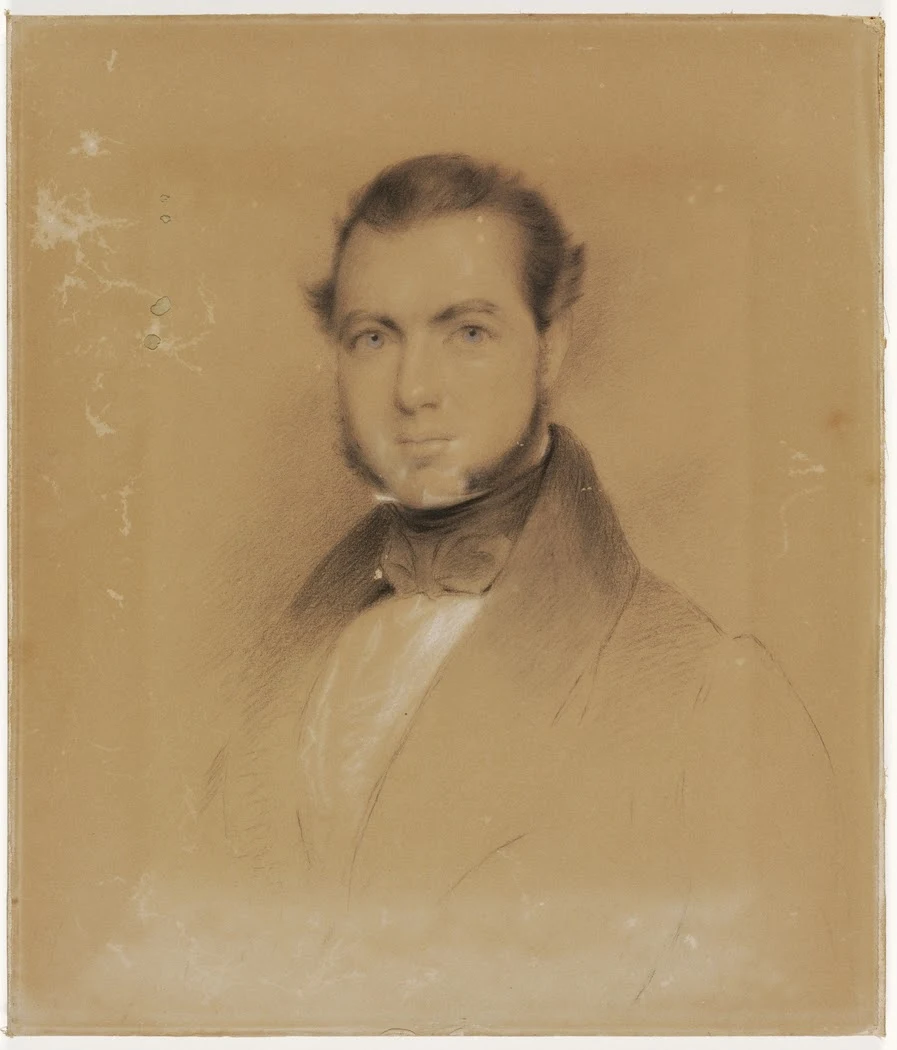
State Library of NSW
Call Number: DG 471
Digital Order No.: a2450001
Caption: [Ronald Gunn], 1848 / Thomas Bock
Tasmanian Flora: The Botanists, Backhouse, Hooker, Rodway, Curtis & Morris
Royal Botanical Gardens, Hobart
Photo copyright © KLW NFC 2014
4. A memorial to the two children George and Sarah Johnson murdered in September 1865 who, had they been in school (they lived nearby on the Tolosa Estate), might have avoided the man called William Griffiths who entered their house, stole a clock, and allegedly murdered them as witnesses to his theft. Griffiths was executed at the Hobart Gaol on December 2, 1865. This account was reported on 25 September,1865:
HORRIBLE MURDER IN TASMANIA.Source: HORRIBLE MURDER IN TASMANIA. (1865, September 25). Empire (Sydney, NSW : 1850 - 1875), p. 2. Retrieved April 16, 2014, from https://nla.gov.au/nla.news-article64144357
In the Hobart Town Advertiser the following appears:---A report reached town yesterday afternoon that a murder of a most revolting and brutal character had been committed at Glenorchy the victims being a boy and a girl, the children of a man named Michael Johnson, who with his wife and family resided in a bark hut near Mr. Hull's residence at Tolosa. The father and mother are hard-working people; the former a carrier, who conveys loading and timber for piles to Hobart Town. It would seem they were in the habit of leaving the hut in the charge of the girl aged about ten years, and the boy eight years. During the absence of the parents the girl was murdered and the boy so injured as to be insensible. The shocking intelligence having reached the ears of the mother, she hastened to the hut, and found the girl quite dead, with three severe wounds on the head, which had evidently fractured the skull. The boy was still living, but quite insensible. Information was conveyed to the Glenorchy police, and superintendent Hunter lost no time in putting all his available force in motion, if possible to discover the perpetrator of that fearful murder. No one was seen lurking about the premises, and the perpetrator of this shocking murder is for the present at large and undiscovered. The Mercury of the following day adds : --- "The supposed murderer of the two unfortunate children at Glenorchy, on Tuesday, for both of the victims of the fearful crime are now dead, was apprehended in Hobart Town, yesterday morning, at about half-past 11, by superintendent Hunter, rural police, and C. D. C. Jones; but before detailing any of the few particulars accompanying the arrest, we must state that the poor boy died about 11 o'clock on Tuesday night, and, sad to say, without having previously to death recovered consciousness sufficient to enable him to give, evidence, as to the barbarian by whom his sister and himself had been so foully and so fatally dealt with. With respect to the apprehension of the person charged with the commission of these horrible crimes, we are informed that the police had their suspicion directed towards a farm labourer named William Griffiths, lately in the employ of Mr. McDermott, of Glenorchy. Griffiths was tracked to town, and yesterday morning C. D. C. Jones, accompanied by superintend Hunter, went to the King's Arms public-house Murray-street, and inquired for Griffiths, who it was stated was not there.

Alfred Bock sketch of William Griffiths
Supreme Court Hobart October 1865
Photographers M. Allport, S. Clifford & T. Nevin
Although Morton Allport was an amateur and not a commercial photographer, he assisted a young Thomas J. Nevin at the beginning of his professional career, and no doubt on account of his friendship with Thomas' sister Mary Ann and their father John Nevin at Kangaroo Valley. When Thomas Nevin joined prolific professional photographer Samuel Clifford, their work became indistinguishable, especially in the production of hundreds of stereoscopic views. The difference, however, between some of Allport's stereos and Clifford & Nevin's, visible more so today because of the fuzziness resulting from the porous salt paper which the latter often (but not always) used, is evident in this example. The first is a dry plate photograph by Morton Allport, 1863, the second is a reprint of the same image from the partnership of Samuel Clifford and Thomas Nevin, 1865.

Boviak Beach, Excursion to Lake St. Clair February 1863 by Morton Allport
Tasmanian Archive and Heritage Office: Allport Library and Museum of Fine Arts
AUTAS001136194164 Also on TAHO at Flickr page

Title: Lake St Clair
Publisher: ca. 1865
ADRI: AUTAS001124851494
Source: W.L. Crowther Library
Series: Views in Tasmania
Notes: On verso: title inscribed in ink on centre of label ; printed above title: Views in Tasmania ; printed below title: S. Clifford, photographer, Hobart Town

Title: Orphan Schools, New Town / Clifford photo
Creator: Clifford, Samuel, 1827-1890
ADRI: AUTAS001136189297
Source: W.L. Crowther Library
RELATED POSTS main weblog
- The early deaths of Thomas Nevin's sisters Rebecca Jane and Mary Ann
- "Lines on the much lamented death of Rebecca Jane Nevin" by John Nevin 1866
- Thomas Nevin's stereo of sister Mary Ann at New Town rivulet
- On the road with Samuel Clifford and Thomas Nevin 1874
- Clifford and Nevin, Hobart Town: tinted cartes








